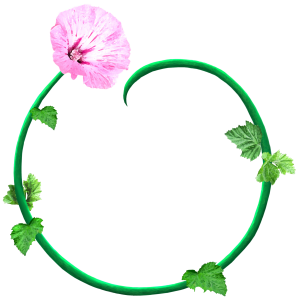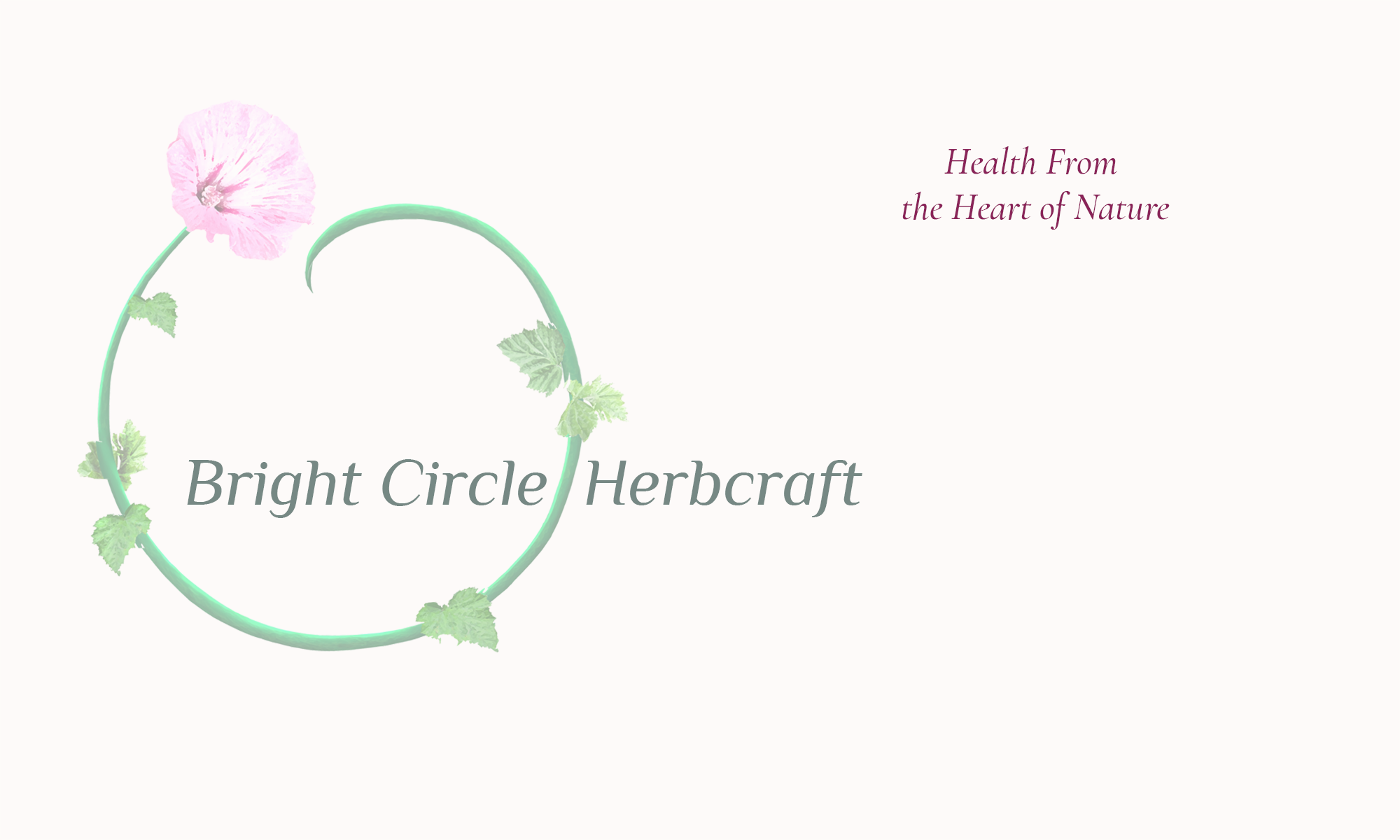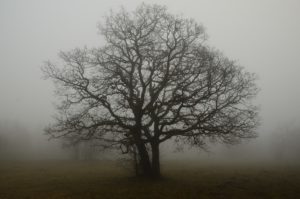
Normally my words would wander among the seeds and grains at this, the Autumn Portal, and the Second Harvest. But as I gave thought to this entry, my reflections turned to another aspect of harvest: Part of processing the grain is sorting what we do not want — the chaff, the stalks and browning leaves from the golden ripe seeds. Part of this, and any harvest is knowing what to leave behind, to compost; and it seemed a fitting theme for where we find ourselves.
This year I clung to summer well into September as it faded away and the days turned golden. The heat broke early after three milder and damper months than is usual, and never returned with force. At the balance of day and night a threshold… and summer slipped away. Time flows, and there is no going back. Trying to snatch at it’s coattails was to no avail, and autumn unfolded: beautiful, and uncaring of my desires. Happily, I love autumn too, but I lingered in a summer I was reluctant to leave.
Things No Longer Needed
There comes a time when we must go forward, and we cannot carry everything with us. The theme of this time, whether we have suffered inconvenience at one end of the spectrum, or personal loss at the other, seems to be one of releasing. Releasing what doesn’t serve us; releasing old ways of doing things that fostered our arriving here, where we now find ourselves; releasing old patterns where we were content to ride on what was comfortable, even as the world around us signaled that our way of life damaged it, and a change was due.
Equilibrium
Nature never does anything for only one reason. In her quest for equilibrium she serves all of herself and all of life intelligently, creating forms that work, to replace those that produce an unbalanced or pathological outcome. Even fires and viruses are part of that evolution, and reveal where we have created conditions for them to thrive though our decisions and cultural expression. Taking a bigger view can help us question our role in contributing to live markets, confined animal feeding operations, habitat loss and temperature change that are only some of the things that have brought us to this pass. Then we have an opportunity to choose what to change, and what no longer serves us, our country or our world.
Herbs for Change
My beloved Celtic mother used to say, “Peace in Your Heart”.
There is a category of herbs that say that to us too, as they promote heart’s ease, and encourage flow. My favorites are:
Reishi Mushroom (Ganoderma lingzhi).
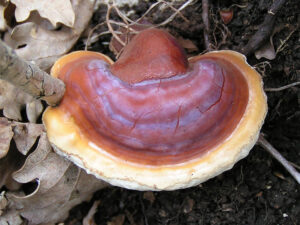
It’s positive actions and properties are too numerous to list, but paramount among them are it’s ability to quiet the heart spirit, lower blood pressure, sustain the heart muscle, protect the liver, and ease the flow of blood, qi, and spirit. Try taking 25-40 drops of the tincture about 15 minutes before you plan to reflect on a bigger picture of something you are working with, or decisions you are making. Pause and sit when you take it, and allow yourself to just be, sensing your breath, body and spirit as the Reishi nourishes you. Then turn your mind to the patterns or changes you are reflecting on, and write down what comes up. Answers may not surface just then, but the space for quietude and heart flow allow your subconscious to really work for you, and you may find that you have flashes of insight and clarity about your concerns in the days to come. When I engage with Reishi in this way, I do it in the evening, not long before bed. It is food-like, and safe to take in moderation. Health food stores usually carry it in tincture form.
Albizia, the Happiness Tree (Albizia julibrissin).
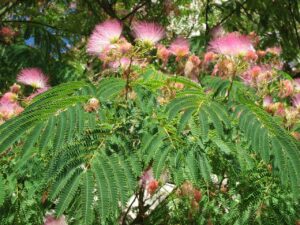
You will know her as Mimosa! With her antidepressant and anti-anxiety properties, she is an ally in times of stress, anxiety and grief. If you have been suppressing anger or grief, this herb can support you when you are ready to work with them. In traditional Chinese medicine it is said to “calm the five organs and promote happiness”. It supports oxytocin levels in the body, and it should not be used if you are pregnant.
Lemon Balm (Melissa officinalis).
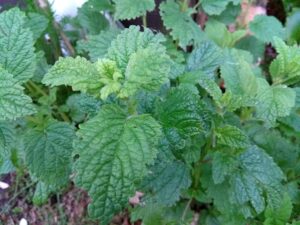 I’ve mentioned it before as an herb to ease stress, so I’ve just copied my previous entry: It is a member of the mint family, that comes to us from southern Europe. Its name Melissa comes from the Greek for “bee”. (Bees love it!) Calming, Mildly sedative and antidepressive — what’s not to love! It has been naturalized here for a long time, and is a favorite for its soft energy, strong presence, and delicate fragrance. Avicenna, a middle eastern herbalist who taught and practiced during the middle ages, recommended it to “make the heart merry”. It nourishes the nerves and has antiviral properties, making it a favorite in times of viral illness. Try a cup of relaxing lemon balm tea as you stop the clock to unwind; or snip fresh leaves into a salad for added flavor and an uplifting treat for your spirit.
I’ve mentioned it before as an herb to ease stress, so I’ve just copied my previous entry: It is a member of the mint family, that comes to us from southern Europe. Its name Melissa comes from the Greek for “bee”. (Bees love it!) Calming, Mildly sedative and antidepressive — what’s not to love! It has been naturalized here for a long time, and is a favorite for its soft energy, strong presence, and delicate fragrance. Avicenna, a middle eastern herbalist who taught and practiced during the middle ages, recommended it to “make the heart merry”. It nourishes the nerves and has antiviral properties, making it a favorite in times of viral illness. Try a cup of relaxing lemon balm tea as you stop the clock to unwind; or snip fresh leaves into a salad for added flavor and an uplifting treat for your spirit.
Lavender (Lavendula angustifolia, or spp.)
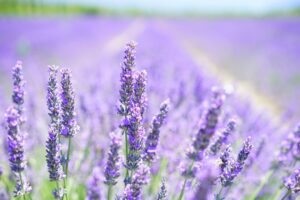 Lavender tea, ½ teaspoon +/- to a cup of boiling water poured over it, is a supreme source of ease on many levels. You get the full fragrance of the buds that way, and the smell is part of the medicine. It’s bitter though, and honey is fine. The bitter property tells us that it will ease digestion (It’s used in many French culinary blends for this), and in fact, it also eases liver tension. If you feel that you emotions are “stuck”, and you just can’t get anywhere with sorting things out, try letting it all go for awhile, then when you are ready, sit with a cup of strong honeyed lavender tea, and sneak up on a little reflection time. Note: Lavender essential oil does not act in the same way as the tea does. Essential oils are not herbs. (They are a highly refined fraction consisting only of the volatile oils, and are missing many of the medicinal constituents of the whole herb.) Use lavender mindfully if pregnant, and avoid if the pregnancy is delicate.
Lavender tea, ½ teaspoon +/- to a cup of boiling water poured over it, is a supreme source of ease on many levels. You get the full fragrance of the buds that way, and the smell is part of the medicine. It’s bitter though, and honey is fine. The bitter property tells us that it will ease digestion (It’s used in many French culinary blends for this), and in fact, it also eases liver tension. If you feel that you emotions are “stuck”, and you just can’t get anywhere with sorting things out, try letting it all go for awhile, then when you are ready, sit with a cup of strong honeyed lavender tea, and sneak up on a little reflection time. Note: Lavender essential oil does not act in the same way as the tea does. Essential oils are not herbs. (They are a highly refined fraction consisting only of the volatile oils, and are missing many of the medicinal constituents of the whole herb.) Use lavender mindfully if pregnant, and avoid if the pregnancy is delicate.
I hope these herbs will be friends for you, as they are for me. May you walk in sunshine and green spaces, and your autumn be golden. —Joan
If you would like to learn more about herbal lifestyles and reweaving your connections with earth rhythms, click here to visit Joan’s events page and
Watch for the Prairie Star Herbalist Connection,
a unique online learning zone
Coming Soon!
You can follow Joan on facebook here.
